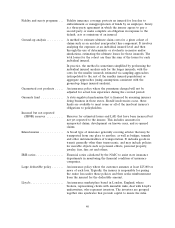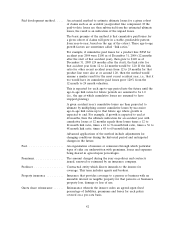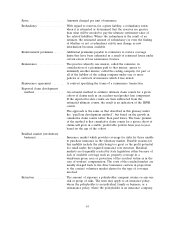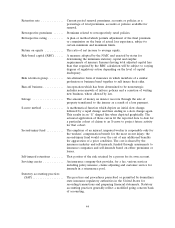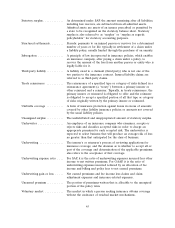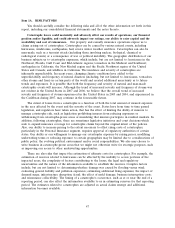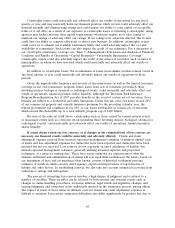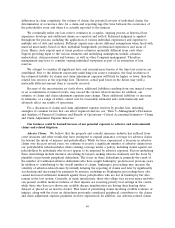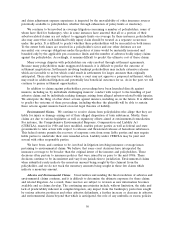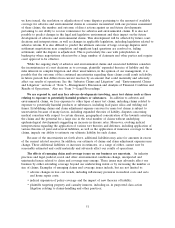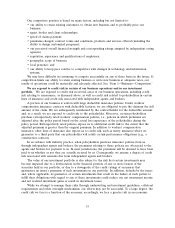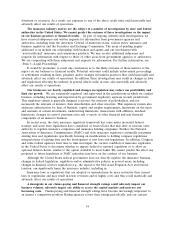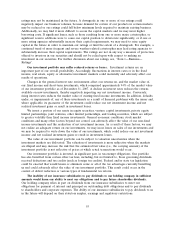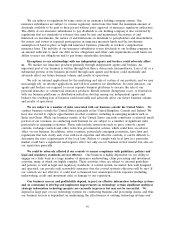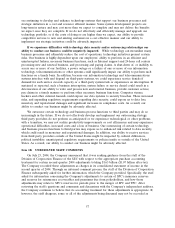Travelers 2007 Annual Report Download - page 59
Download and view the complete annual report
Please find page 59 of the 2007 Travelers annual report below. You can navigate through the pages in the report by either clicking on the pages listed below, or by using the keyword search tool below to find specific information within the annual report.Item 1A. RISK FACTORS
You should carefully consider the following risks and all of the other information set forth in this
report, including our consolidated financial statements and the notes thereto.
Catastrophe losses could materially and adversely affect our results of operations, our financial
position and/or liquidity, and could adversely impact our ratings, our ability to raise capital and the
availability and cost of reinsurance. Our property and casualty insurance operations expose us to
claims arising out of catastrophes. Catastrophes can be caused by various natural events, including
hurricanes, windstorms, earthquakes, hail, severe winter weather and fires. Catastrophes can also be
man-made, such as a terrorist attack (including those involving nuclear, biological, chemical or
radiological events) or a consequence of war or political instability. The geographic distribution of our
business subjects us to catastrophe exposures, which include, but are not limited to: hurricanes in the
Northeast, Florida, Gulf Coast and Mid-Atlantic regions; tornadoes in the Midwest and Southeast;
earthquakes in California, the New Madrid region and the Pacific Northwest region of the United
States and Canada; and wildfires in California. The incidence and severity of catastrophes are
inherently unpredictable. In recent years, changing climate conditions have added to the
unpredictability and frequency of natural disasters (including, but not limited to, hurricanes, tornadoes,
other storms and fires) in certain parts of the world and created additional uncertainty as to future
trends and exposures. It is possible that both the frequency and severity of natural and man-made
catastrophic events will increase. Although the trend of increased severity and frequency of storms was
not evident in the United States in 2007 and 2006, we believe that the overall trend of increased
severity and frequency of storms experienced in the United States in 2005 and 2004, and experienced in
the Caribbean during 2007, may continue in the foreseeable future.
The extent of losses from a catastrophe is a function of both the total amount of insured exposure
in the area affected by the event and the severity of the event. States have from time to time passed
legislation, and regulators have taken action, that has the effect of limiting the ability of insurers to
manage catastrophe risk, such as legislation prohibiting insurers from reducing exposures or
withdrawing from catastrophe-prone areas or mandating that insurers participate in residual markets. In
addition, following catastrophes, there are sometimes legislative initiatives and court decisions which
seek to expand insurance coverage for catastrophe claims beyond the original intent of the policies.
Also, our ability to increase pricing to the extent necessary to offset rising costs of catastrophes,
particularly in the Personal Insurance segment, requires approval of regulatory authorities of certain
states. Our ability or our willingness to manage our catastrophe exposure by raising prices, modifying
underwriting terms or reducing exposure to certain geographies may be limited due to considerations of
public policy, the evolving political environment and/or social responsibilities. We also may choose to
write business in catastrophe-prone areas that we might not otherwise write for strategic purposes, such
as improving our access to other underwriting opportunities.
There are also risks that impact the estimation of ultimate costs for catastrophes. For example, the
estimation of reserves related to hurricanes can be affected by the inability to access portions of the
impacted areas, the complexity of factors contributing to the losses, the legal and regulatory
uncertainties and the nature of the information available to establish the reserves. Complex factors
include, but are not limited to: determining whether damage was caused by flooding versus wind;
evaluating general liability and pollution exposures; estimating additional living expenses; the impact of
demand surge; infrastructure disruption; fraud; the effect of mold damage; business interruption costs;
and reinsurance collectibility. The timing of a catastrophe’s occurrence, such as at or near the end of a
reporting period, can also affect the information available to us in estimating reserves for that reporting
period. The estimates related to catastrophes are adjusted as actual claims emerge and additional
information becomes available.
47





